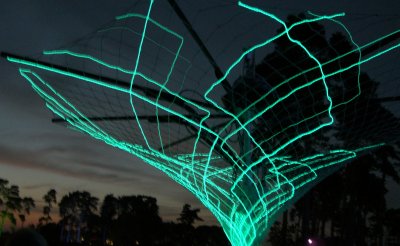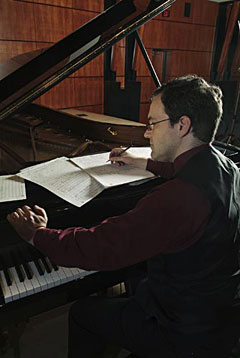 The Los Angeles Master Chorale gave the premiere of a new work by Eve Beglarian for full chorus and two Persian instruments. The work is “Sang”, Persian for “stone”, taken from a Persian parable that appealed to Beglarian; she added texts in Hebrew and Septuagint Greek from the Hebrew scriptures. Her program notes are here. An English translation of the texts was given in the program, but no attempt was made to provide surtitles; the thing to do was to relax and be absorbed into the sounds.
The Los Angeles Master Chorale gave the premiere of a new work by Eve Beglarian for full chorus and two Persian instruments. The work is “Sang”, Persian for “stone”, taken from a Persian parable that appealed to Beglarian; she added texts in Hebrew and Septuagint Greek from the Hebrew scriptures. Her program notes are here. An English translation of the texts was given in the program, but no attempt was made to provide surtitles; the thing to do was to relax and be absorbed into the sounds.
The work was the first in a planned series of commissions for the Master Chorale, LA is the World, in which a particular cultural background will be honored in works for chorus. With her selection of a Persian parable at the center of the work, Beglarian decided to link Persian musicians with western singers to create a work compatible with both traditions. Supporting the vocalists, sometimes as accompanists, sometimes in the lead, were Manoochehr Sadeghi playing the santur, a 72-string hammered dulcimer, and Pejman Hadadi on percussion, notably several sizes of daf, a frame drum, and the tombak, a goblet-shaped drum. The instrumental duets seemed to successfully blend improvisational heritage with western structures so that the flow between chorus and instruments was smooth.
A commission of this sort should have incorporated recording and distribution. It deserves hearing. I’d certainly like to hear it again, but it may take the Chorale three years or so before the work gets on another program. But are there that many brave boards out there, boards that will program a choral work with words in Persian, Hebrew and Greek that requires Persian instrumentalists?
The Master Chorale audience is really fairly open to newer music, especially for an audience that makes me seem young when I mingle with them. The program last night began with James MacMillan’s Magnificat (1999) and Nunc Dimittis (2000) with David Goode on the WDCH organ. The second half of the program was Arvo Part’s Te deum (1984-1985; 1992 revision). This masterwork requires a string orchestra, piano, recorded tape of a wind harp giving the sustaining pitches throughout the work, and three choruses. Grant Gershon placed the men’s chorus in the left-center rafters and the women’s chorus in the right center, placing the mixed chorus on stage behind the strings. The sound was lovely.
The Part work was also a nice link to the Philharmonic’s “Shadow of Stalin” series of programs, which ended that afternoon with the orchestra playing Prokofiev’s complete Alexander Nevsky to accompany the Eisenstein film. The music is glorious, but the film isn’t. Imagine putting together the three worst WW II films out of Republic studios, and you approach the jingoism of the film. (The music was a re-thinking of the film score, starting from Prokofiev’s cantata and applying it backwards to fit the movie, ignoring some dialogue to increase the musical values.) The preceding Thursday was a concert of composers searching for musical freedom and using folk music to reflect nationalism and implied anti-Soviet resistance. Ligeti’s Concert Romanesc (1951) was an Enesco-like work that was still controversial enough to get banned for twenty years after a single rehearsal. Lutoslawski’s brilliantly-colored Concerto for Orchestra (1954) was able to pass. Karel Husa’s powerful Music for Prague 1968 was the statement of an emigre against the re-conquering of Czechoslovakia after the brief “Prague Spring”.
Last week’s concert was by three young composers, writing wild music until the 1936 crackdown came. Gavriil Popov wrote a suite from his Komsomol Patron of Electrification, which opened the concert; the score was ready for release when the Government objected to contemporary music and it went unheard for 46 years. Alexander Mosolov wrote The Iron Foundry in 1926-1927 as part of a ballet (which was actually performed in Hollywood Bowl in 1931 as part of a different ballet) — great clanging music by a composer not able to adapt to new rules. And there was a young composer named Shostakovich who wrote astounding operas: The Nose and Lady Macbeth of the Mtsensk District. We heard the composer’s suite from the former and the Act I, Scene 3 from the latter (the scene with the xxx-rated trombone part). Shostakovich survived, of course, but never again with the freedom, and never another opera.

 The
The 
 First Jeff Harrington, then David Salvage, and now our very own
First Jeff Harrington, then David Salvage, and now our very own  The Los Angeles Master Chorale gave the premiere of a new work by
The Los Angeles Master Chorale gave the premiere of a new work by